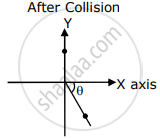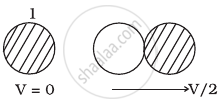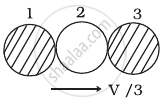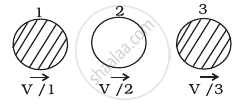Advertisements
Advertisements
प्रश्न
Two identical ball bearings in contact with each other and resting on a frictionless table are hit head-on by another ball bearing of the same mass moving initially with a speed V as shown in figure.

If the collision is elastic, which of the following (Figure) is a possible result after collision?
पर्याय
उत्तर

Explanation:
In a collision, if the motion of colliding particles before and after the collision is along the same line, the collision is said to be head-on or one-dimensional.
When two bodies of equal masses collide elastically, their velocities are interchanged.
Kinetic energy and linear momentum remain conserved Total kinetic energy of the system before the collision
= `1/2 mv^2 + 0 = 1/2 mv^2`
In (a), kinetic energy of the system after the collision.
`k_1 = 1/2 (2m) (v/2)^2 = 1/4 mv^2`
Hence this option is incorrect.
In (b), kinetic energy of the system after the collision.
`k_2 = 1/2 (m) (v)^2 = 1/2 mv^2`
Hence this option will be correct.
In (c), kinetic energy of the system after the collision.
`k_3 = 1/2 (3m) (v/3)^2 = 1/6 mv^2`
Hence this option is incorrect.
In (d), kinetic energy of the system after the collision.
`k_4 = 1/2 mv^2 + 1/2 m (v/2)^2 + 1/2 m(v/3)^2 = 49/72 mv^2`
We see that kinetic energy is conserved only in (b).
APPEARS IN
संबंधित प्रश्न
A trolley of mass 200 kg moves with a uniform speed of 36 km/h on a frictionless track. A child of mass 20 kg runs on the trolley from one end to the other (10 m away) with a speed of 4 m s–1 relative to the trolley in a direction opposite to the its motion, and jumps out of the trolley. What is the final speed of the trolley? How much has the trolley moved from the time the child begins to run?
Answer the following question.
Obtain its value for an elastic collision and a perfectly inelastic collision.
Solve the following problem.
A ball of mass 100 g dropped on the ground from 5 m bounces repeatedly. During every bounce, 64% of the potential energy is converted into kinetic energy. Calculate the following:
- Coefficient of restitution.
- The speed with which the ball comes up from the ground after the third bounce.
- The impulse was given by the ball to the ground during this bounce.
- Average force exerted by the ground if this impact lasts for 250 ms.
- The average pressure exerted by the ball on the ground during this impact if the contact area of the ball is 0.5 cm2.
Explain the characteristics of elastic and inelastic collision.
What is inelastic collision? In which way it is different from an elastic collision. Mention a few examples in day-to-day life for inelastic collision.
A mass M moving with velocity 'v' along x-axis collides and sticks to another mass 2M which is moving along Y-axis with velocity 3v. After collision, the velocity of the combination is ______.
Consider a one-dimensional motion of a particle with total energy E. There are four regions A, B, C and D in which the relation between potential energy V, kinetic energy (K) and total energy E is as given below:
Region A : V > E
Region B : V < E
Region C : K > E
Region D : V > K
State with reason in each case whether a particle can be found in the given region or not.
A rod of mass M and length L is lying on a horizontal frictionless surface. A particle of mass 'm' travelling along the surface hits at one end of the rod with velocity 'u' in a direction perpendicular to the rod. The collision is completely elastic. After collision, particle comes to rest. The ratio of masses `(m/M)` is `1/x`. The value of 'x' will be ______.
A ball of mass 10 kg moving with a velocity of 10`sqrt3` ms–1 along the X-axis, hits another ball of mass 20 kg which is at rest. After collision, the first ball comes to rest and the second one disintegrates into two equal pieces. One of the pieces starts moving along Y-axis at a speed of 10 m/s. The second piece starts moving at a speed of 20 m/s at an angle θ (degree) with respect to the X-axis.
The configuration of pieces after the collision is shown in the figure.
The value of θ to the nearest integer is ______.

Answer carefully, with reason:
Is the total linear momentum conserved during the short time of an inelastic collision of two balls ?



